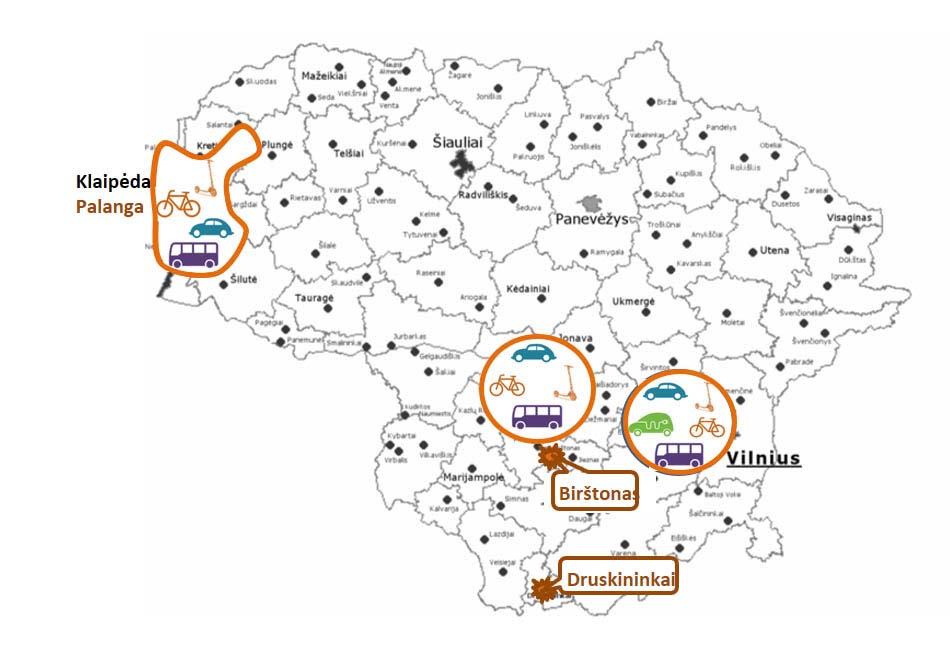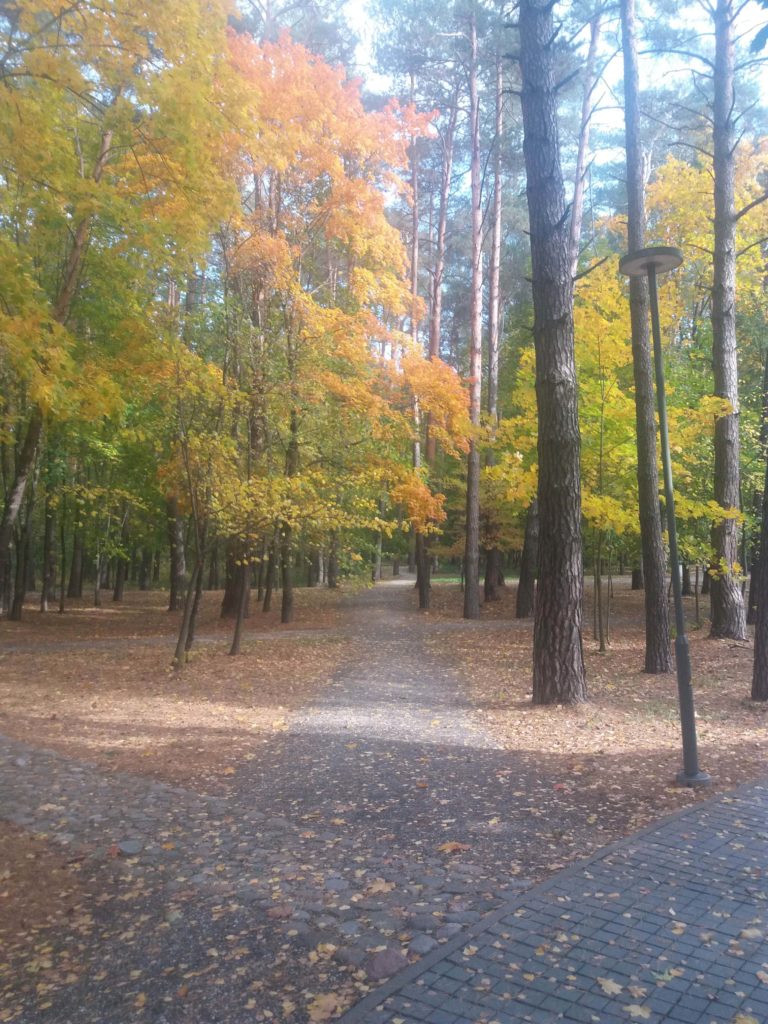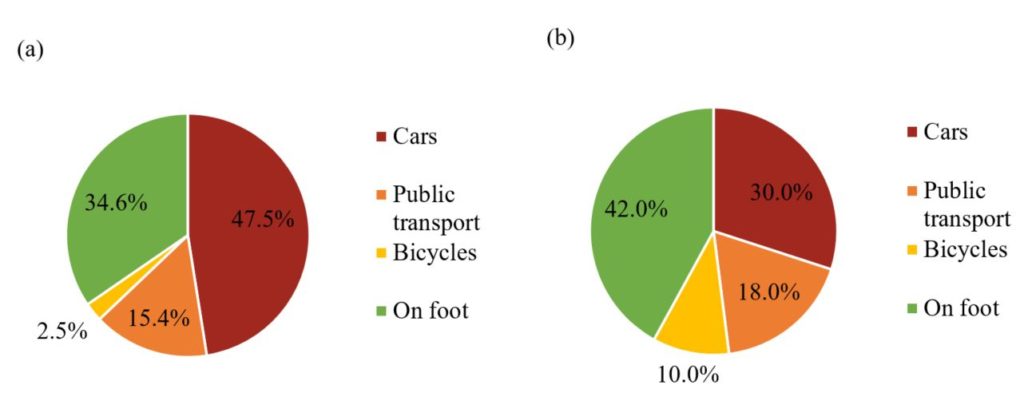
Analysing the possibility to extend urban sharing mobility solutions to remote touristic areas in Lithuania
“With changes in the population in the rural areas of Lithuania, implementing the new achievements in connectivity, people’s mobility must be ensured inside the regions and connections with other country’s administrative units.
For this case study, we choose to analyse the possibility of implementing car sharing service in a region with a low population density in the central part of Lithuania. Such a solution may increase the attractiveness of the region for the residents and tourists. We also analysed micro-mobility solutions (such as e-scooters, bikes, etc.) during our research, as they will improve connectivity inside selected areas and are environmentally friendly.” explains VILNIUS TECH researcher Dr Rasa Ušpalytė-Vitkūnienė
Location of Birštonas resort
The territory of Birštonas municipality is located in the eastern part of the regional park Nemunas Loops. Birštonas is oriented on rehabilitation and tourism services and is the regional significance centre. The development of Birštonas regional park of river Nemunas Loops and Birštonas Resort City is closely interlinked.
There are some challenges related to the mobility and accessibility of the Birštonas region. Many arrived guests/ tourists with private cars and quite intensive traffic and the town form an unattractive image of the resort, increases noise and air pollutions and defaces the background of nature/ surroundings of the resort town.
On the other hand, the absence of connection by railways does not assurance the free choice of transport mode for inhabitants and tourists/guests.
The main barriers/ impediments which should be removed for developing sustainable mobility in the Birštonas region are: |
|
The modal split in Birštonas: a) current situation; b) prognosis for 2030 (Data source: SUMPs’ of the chosen towns)
As shown in the Figure above, by the year 2030, the number of trips carried by private cars should decrease from 47.5 % to 30.0%. On the other hand, the number of bicycle journeys should grow from 2.5 % to 10.0% (4 times). So, a part of trips by private cars needs to be replaced with journeys by bicycles and on foot.
During the project, the meetings with stakeholders were initiated, the surveys were prepared for possible service users to identify mobility needs in Birštonas resort and municipality and assess accessibility. A survey of residents and tourists (guests) was conducted in the winter of 2019/2020 and the spring and summer of 2020. The residents’ share is 73% of all respondents, and tourists are 27%, respectively. It is important to note that reaching a larger sample of tourist responses was limited by the pandemic situation of COVID-19. One of the survey’s main objectives was to identify mobility needs in resorts in terms of new transportation modes implementation. The acceptance of the car sharing system is presented in the Figure below due to tourists’ (guests’) and residents’ surveys. They represent the respondents willing to use a car sharing system if it appears at the resorts.
Distribution of respondents’ answers to the question on whether they would use the car sharing system if it appeared next month at the resort, by type of sharing mode: (a) Residents, (b) Tourists (Guests)
By comparing the interest of tourists (guests) and residents, it can be seen that tourists (guests) are more inclined to use the sharing platform in the resort. The least needed type of sharing system, according to resort residents, is car sharing. About 20% of the population expressed interest in this mode of transport. Among tourists (guests), this number is higher and reaches 32%.
The resort is more convenient for the short distances to cover foot trips or micro-mobility solutions. According to the survey, mobility needs suggest that the resort should prioritise bicycles and low-power electric vehicles. The shared car becomes essential when it comes to reaching places outside the town. A car sharing system could improve the resort’s accessibility to the guests while also serving the residents. Compared to the residents, the tourists (guests) prefer a transport-sharing system, regardless of the mode of transport. However, such a system could benefit those residents who are unable and unwilling to operate their own car or use it infrequently.

Several tendentious answers can be distinguished by analysing the textual explanations of why the respondents chose one or another answer about using the sharing system. Most respondents understand and accept car sharing as a system that works within the city. Therefore, from the residents’ perspective, a negative attitude towards it is being formed as a potential load on the town streets and parking lots and growing pollution in the resort. Others view the car sharing positively as a possible service for tourists, as well as the possibility of easier access to Kaunas, Vilnius, the international airports.
Analysis of existing solutions showed that car sharing services in Lithuania are widespread in the biggest urban areas, with more than 150,000 population. Sharing mobility providers working in urban areas do not expand to the rural areas as the existing business model is not profitable.
There are a few possible solutions for attracting B2C service providers to remote areas of the country.
- The first is to subsidise this transport mode, as it is done for public transport.
- The second opportunity is to define an additional fee for the service user. Additional costs for companies appear during returning vehicles from such an area if they are left in a rural area.
- The third opportunity, for companies to provide access to their platform for pier-to-pier service. For example, companies providing micro-mobility solutions may be interested in giving access to their Apps for classical renting companies working in the region. The situation in car sharing is somewhat different. Business representatives see many risks and are unwilling to access their App to third parties, such as conventional renting companies or individuals. The car sharing company’s primary risk is that it cannot ensure the rented vehicle’s technical condition. Another solution is an Apps developed for the selected rural area or renting existing software solutions.
A car sharing system in remote regions would improve residents’ connectivity with other cities, eliminate the need for their own car (or at least a second car in the family). Upon arrival in the country by plane or train, foreign guests could more easily reach the resorts from the international airports and railway stations of the biggest cities of Lithuania. It would be easier for tourists to visit the attraction point places located farther from the resort.











